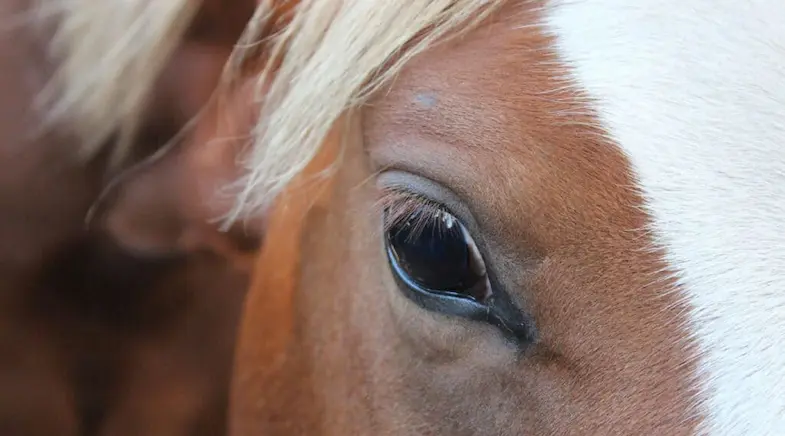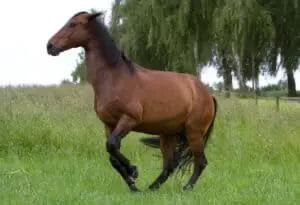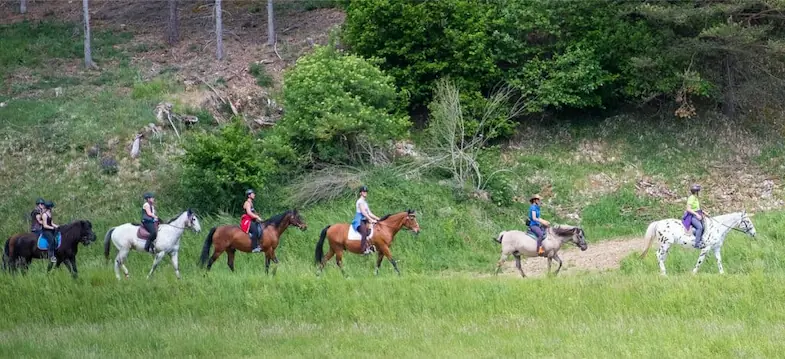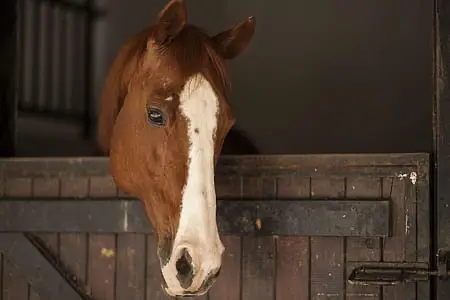We all think of cataracts as a problem that affects people as they get older but it can occur in all mammals which means that horses are just as susceptible to cataracts as we are. That doesn’t mean to say that they will actually ‘suffer’ with the condition though.
What is a cataract?
Ask anybody what a cataract is and they’ll most likely tell you that it’s an eye condition where the lens of the eye turns cloudy and stops the eye from working properly which to some extent is true but that’s a very general description of the condition. The center of the lens (known as the nucleus) forms before a foal is born but the rest of the lens will continue to develop throughout the horse’s life as tiny layers of cells stretch around the eye. Any damage (or inflammation) to these cells will cause the lens to lose some of its transparency, this means that not so much light can get through and as a result, the vision is affected.
There are three types of cataracts but not all will affect your horse’s vision:
- Incipient – Sometimes called early cataracts, this will only affect the smaller part of the lens and doesn’t normally display any clinical signs and no loss of sight.
- Immature – Despite its immature name, this type of cataracts is far more serious than incipient cataracts. It also causes a loss of vision that deteriorates with age.
- Mature – This is the most serious type of cataracts and affects the whole of the lens, if it’s not treated it will often result in blindness.
Many people wrongly think that if a horse has cataracts they’ll become completely blind over time but this couldn’t be further from the truth. While a cataract does block out the light, the amount that is blocked will be determined by the severity of the cataract. In most cases, horses will still be able to make a meaningful picture out of the light, albeit a somewhat blurry or foggy picture.
What causes cataracts in horses?
There’s no one single cause for cataracts and, despite common misconceptions, can actually affect a horse at any stage of its life. Most cataracts can develop in one eye (unilateral) or both eyes (bilateral).
- Congenital – This is present at birth and is often caused when the dam suffers from an infection, is exposed to toxins, or suffers from poor nutrition while the foal is developing.
- Hereditary – While a horse won’t necessarily inherit cataracts from its parents it can happen, especially in some breeds such as the Thoroughbred and the Morgan (although inherited cataracts in Morgans is less likely to affect their site).
- Disease – Cataracts can be caused by some infections and diseases such as periodic ophthalmia and equine uveitis.
- Damage or inflammation – If the horse has suffered damage that affects the blood or nutrition supply to the lens, whether it’s from an injury or inflammation, the lens will become displaced and cataracts will develop. Much like the sort of scar we get if we cut ourselves, although in the eye that damage doesn’t heel.
- Deficiency or toxins – Nutritional deficiencies as well as exposure to some toxins can trigger cataracts, this is one of the reasons why it’s so important that you make sure your horse has a balanced diet as well as keeping the pasture clear of poisonous plants.
- Age – Sometimes referred to as progressive or true senile cataracts, it’s a normal part of the aging process and is most common in horses over the age of 15. A recent study found that approximately 1 in 8 horses over 15 will suffer from cataracts, although that doesn’t mean they’ll lose their sight.
What are the signs of cataracts in horses?
There are varying degrees of cataracts and it can often develop very slowly so it’s not always obvious that a horse has the condition, especially when many cases won’t affect the horse’s vision to the extent that it impacts on their daily life.
When you consider that a cataract can be so small that even a trained veterinarian with specialist equipment can on see it in a darkened stall its no wonder that many owners aren’t aware that their horse has it.
As with any condition there are a number of things to look out for though:
- Stumbling or tripping
- Walking into objects (or people)
- Unable to walk in a straight line
- Abnormal (and often frequent) facial injuries
- Alteration in head carriage
- Sudden shying
- Increased anxiety and jumpiness
- Cloudy or white opacity to the pupil (often yellowy if the cataract is advanced)
Horses are remarkable adaptable and a cataract is often slow developing so it can be difficult to spot the signs.
How is a cataract diagnosed in horses?
Diagnosing cataracts can be difficult to detect if it’s very small but your veterinarian will use an ophthalmoscope to look into your horse’s eye. He’ll be looking for any opacity of the lens, this will appear as a dark around that isn’t transparent when a bright light is shone at the eye. If a cataract is only small or mild then it may only be possible to see the opacity if the horse is in a dark place without any outside light.
Your veterinarian will also perform multiple tests to assess how your horse moves and whether or not he can see various objects. He may also test your horse’s blink reflex as well as the pupillary light reflex to see if the retina has been detached. Blood tests may be done too to rule out other eye diseases.
If a cataract is found then it’s advisable to have your horse checked again in six to nine months to see if it’s progressed at all.
Can you ride a horse with a cataract?
If your horse’s cataract is only mild and isn’t affecting his vision then there’s absolutely no reason at all why you can’t continue to ride him. A cataract won’t necessarily affect your horse’s vision, but if you’ve noticed that he’s walking into things a lot or is more nervous and anxious while riding out then you should consider not riding him, or at least riding in a more controlled environment such as an arena without any obstacles.
In my opinion, if you’re not sure whether to ride or not I would say don’t, or at least wait and speak to your veterinarian, they’ll be able to advise you on what is best for your horse.
Does a cataract affect a horse’s quality of life?
Horse’s are adaptable creatures and the slow-developing nature of cataracts means that, unless its drastically affecting both eyes, most horses can, and do, live perfectly normal lives. It’s only mature cataracts that is guaranteed to affect your horse’s quality of life.
How do you treat cataracts in horses?
Sadly there is no medicinal treatment, whether it be eye drops, tablets, or injections, for cataracts in horses. The only reliable treatment for cataracts is surgery but this should only be considered as a very last resort. In most cases surgery is successful but, while the horse’s eyesight will be greatly improved and will no longer degrade, the horse will never have ’normal’ vision.
Depending on the severity of the cataracts though, and how much of an impact it has on your horse’s quality of life, surgery to remove it may not be a viable option.
Suitability to cataract surgery
Before your horse is able to have the cataract removed your veterinarian will access him to make sure he doesn’t have and infection, inflammation of other problems that could reduce the effectiveness of the surgery. He will also run a number of tests to make sure your horse is healthy enough to undergo surgery.
Prior to the surgery
If your veterinarian found that your horse was suffering from and infection or inflammation then he’ll prescribe a course of medication to make sure it’s gone before the surgery takes place. It’s known that the operation isn’t usually successful on horses that are suffering from inflammation or infection around their eye.
The surgery
While the operation is relatively quick and straightforward it is also very specialized so your horse may be referred to an ophthalmologist who will carry out the operation, which is called phacoemulsification. The ophthalmologist will use a small wand that produces extremely high-frequency waves, these waves literally shatter the cataract which turns to liquid and is then sucked out using a vacuum. Small absorbable sutures, which take around six to eight weeks to dissolve, are then used to close the area.
After the operation, your horse will stay in the hospital for up to ten days (although seven is typical) to make sure he’s recovered fully and there are no complications.
The recovery process
Once your horse arrives home he’ll require a lot of care, while he’s recovering he’ll need to be kept in a darkened stall with no bright light and little activity. You’ll also be given pain killers, corticosteroids (to reduce inflammation), and antibiotics (to prevent infection) which you’ll have to administer four to five times days for at least three months.
Can you treat cataracts in horses naturally?
Just because there’s no medicinal treatment for cataracts that doesn’t mean to say you can’t use natural remedies to help slow the progress of the cataract. While there’s no cast-iron evidence to show the effectiveness, recent studies have shown that antioxidants such as vitamins C and E can slow the development of a cataract. You can either give your horse supplements that contain antioxidants or you can make sure they have plenty of natural foods that contain them, food such as strawberries and mangos are high in vitamin C while grains and coconut oil both contain a lot of vitamin E.
Conclusion
If you’re not sure if your horse has cataracts though you should speak to your veterinarian for a qualified diagnosis. Just because your horse has a cataract though it doesn’t mean that it will affect his quality of life or your ability to ride him. In most cases, a horse’s eyesight is clear enough for him to lead a normal life but if the cataract is severe enough to warrant surgery then that is always an option.
I hope you found this article helpful. If you did I’d be grateful if you could share it please as it would really help me.
Recommended products
Over the years I have tried hundreds of different horsey products, from various blankets and halters to different treats. Some I’ve loved, others I’ve hated but I thought I’d share with you my top all-time favorite products, the ones I never leave the yard without. I’ve included links to the products (which are in no particular order) that I really think are great.
- Horse Knots by Reference Ready – If you’re like me and enjoy pocket reference guides then you’ll love this knot tying guide. These handy cards can easily fit in your pocket or attach to the saddle for quick reference. They’re waterproof, durable and are color coded to make them easy to follow.
- Mane ’n Tail Detangler – Even if you never show your horse you’ll need to detangle his tail from time to time (and possibly his mane too) which is always a challenging chore! I’ve found that if I run a little bit of detangler through my horse’s tails every few days it stops them from getting matted up and makes combing them easy, even if they’re coated in mud. I don’t know if I should admit to this or not but it also works wonders on my hair.
- TAKEKIT Pro clippers – Over the years I’ve tried a lot of different clippers and while some were obviously better than others I found these to be by far the best. They are heavier than a lot of other clippers but for me, that’s a good thing, it makes them feel more sturdy and hardwearing. On top of that they have a range of speeds so are just as good for clipping your horse’s back as they are his face. I also like the fact that they come in a handy carry case but that’s not for everybody. The company that makes them is super good and incredibly helpful too, a real bonus these days. The only thing I wasn’t keen on was the fact that it doesn’t come with any oil, but that’s not a major problem as it’s not difficult to buy lubricant.
- Shire’s ball feeder – There are so many boredom buster toys out there but I like to use these every day, regardless of whether or not my horses are bored. I find that it helps to encourage my horses to problem solve by rewarding them with treats (or pieces of fruit) but it also mimics their natural grazing behavior which helps to keep them calm and de-stressed.
- Horse safe mirror – This is a strange one that many people are surprised about but I like to put horse safe mirrors in the trailers as well as in the quarantine stalls. It helps to prevent the feeling of isolation by giving the impression of other horses being around. Being herd animals horses can get extremely stressed when they feel that they’re on their own but with these stick-on mirrors, they believe that at least one other horse is with them.
- Rectal thermometer – I know this isn’t glamourous at all but it’s vital for your horse’s well-being to be able to check their temperature and a rectal thermometer is the easiest way of doing this which is why I’ve added it to the list.
Shopping lists
I’ve also put together a few shopping lists of essential items that I’ve found helpful over the years. I’ve broken the lists down into different categories rather than put everything in one massive list 😉





